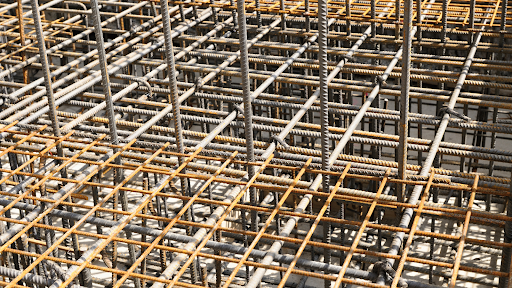What Is a Reo Bar and Why Is It Essential for Concrete Slabs?
A reo bar (reinforcing bar or rebar) is a steel rod embedded within concrete to create reinforced concrete structures that can withstand significant loads. Concrete excels under compression but fails under tension—this is where reo bars become critical.
Steel reinforcing bars provide the tensile strength that concrete lacks. When embedded in slabs, they absorb tensile forces that would otherwise cause cracking and structural failure. The combination creates a composite material where concrete handles compression, whilst steel manages tension.
In Australian construction, reo bars form the backbone of:
- Residential concrete slabs and driveways
- Commercial building foundations
- Bridge decks and infrastructure projects
- Retaining walls and suspended floors
Without proper reinforcement, concrete slabs would crack under minimal stress, leading to costly repairs and potential safety hazards.
How to Cut Reo Bar Safely?
Cutting reo bar demands strict adherence to safety protocols to prevent serious injuries from flying metal fragments and tool-related accidents. Safety gear forms your first line of defence. Wear heavy-duty gloves, impact-resistant goggles, and consider attaching a safety strip to exposed bar ends during the cutting process.
Preparing for the Cut
Before you start cutting, make sure you follow these steps:
- Secure the reo bar firmly in a vice or clamp before making any cuts.
- Movement during cutting creates dangerous kickback and uneven cuts that compromise structural integrity.
- Never attempt to hold the bar by hand whilst operating cutting equipment.
Choosing the Right Tools
Using the right tools is essential for both efficiency and safety when cutting reo bar. Here are some professional-grade tools you can use:
- Rebar cutter (manual or hydraulic): Clean cuts up to 20mm diameter with minimal sparks
- Angle grinder with cutting wheel: Versatile for various bar sizes, requires steady hands
- Chop saw: Fastest option for high-volume cutting, produces hot metal sparks
Avoid using improvised cutting methods such as hacksaws or bolt cutters on thick bars. These tools can increase physical strain and accident risk.
Positioning Yourself Safely
When you’re ready to cut, it’s essential to position yourself safely:
- Stand to the side of the cutting line.
- Never stand directly behind the blade’s path where debris travels.
By following these safety precautions, you can minimise the risk of injuries while cutting reo bar.
What Are the Best Practices for Installing Reo Bar in Concrete Slabs?
Installing reo bar correctly begins with thoroughly cleaning the installation area to remove dirt, debris, and loose materials that could compromise the bond between concrete and steel. A clean surface ensures the reobar sits at the proper height and maintains its position during the concrete pour.
Spacing reo bars follows specific engineering requirements, with a standard 2-foot (600mm) grid pattern commonly used for residential slabs in Australian construction. The bars intersect at right angles, creating a reinforcement mesh that distributes loads evenly across the concrete surface.
Secure each intersection point using wire ties to prevent the reo bar from shifting during concrete placement. The bars should sit on plastic or metal chairs that maintain the correct cover distance from the ground—typically 50-75mm for slabs—ensuring adequate concrete protection around the steel reinforcement.
How Do They Connect New and Old Concrete Sections Using Reo Bars?
To join new concrete to existing slabs without compromising structural integrity, drill precise holes and install dowels through both sections, creating a mechanical bond that transfers loads between old and new concrete.
When working with saw-cut slabs, contractors drill holes at regular intervals along the joint line, typically 300-450mm apart and 150mm deep into the existing concrete. These holes accommodate dowels for connection—smooth or deformed reo bar sections that extend into both the old and new concrete pours.
The dowel diameter usually matches the main reinforcement size, commonly 12mm or 16mm bars. Epoxy resin secures the dowels in the drilled holes, ensuring no movement occurs during the fresh concrete pour. This method prevents differential settlement and maintains load transfer across the joint, significant for driveways, warehouse floors, and industrial slabs where heavy loads cross the connection point.
How Can Reobar Safety Protection Strips Prevent Site Injuries?
Safety strips on reo bars create a protective cushioning layer that significantly reduces injury severity when workers accidentally contact exposed reinforcement. These brightly coloured caps transform protruding rebar from invisible hazards into highly visible safety markers across construction sites.
The enhanced visibility alone prevents countless accidents. Workers navigating busy sites can spot capped reobars from a distance, avoiding dangerous collisions that could cause puncture wounds or deep lacerations. The soft protective material absorbs impact energy, turning what might be a serious puncture injury into a minor bump.
Key protective benefits include:
- Prevention of puncture wounds from exposed reobar ends
- Reduced abrasion injuries during close-proximity work
- Clear visual warnings in low-light conditions
- Protection for workers who may trip or fall near reinforcement areas
Installing safety strips takes seconds per rebar but delivers measurable safety improvements. Construction sites using these protective covers report fewer medical incidents and reduced workers’ compensation claims. Ready to enhance your site safety standards? Contact Covert Procurement for quality reo bar safety strips and expert guidance on creating safer construction environments.

